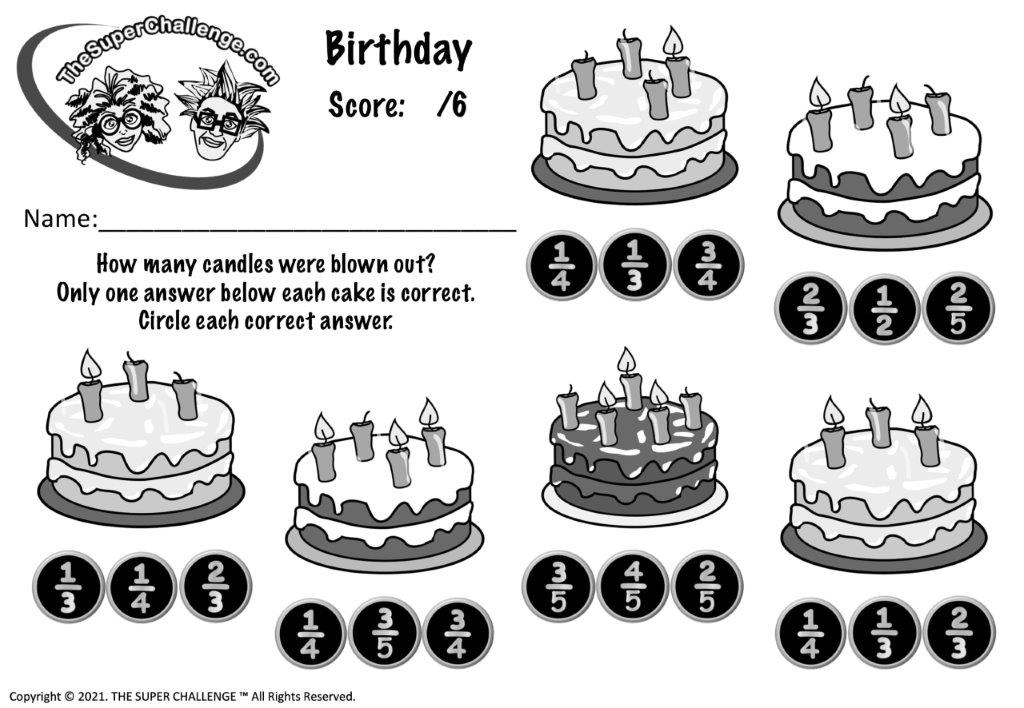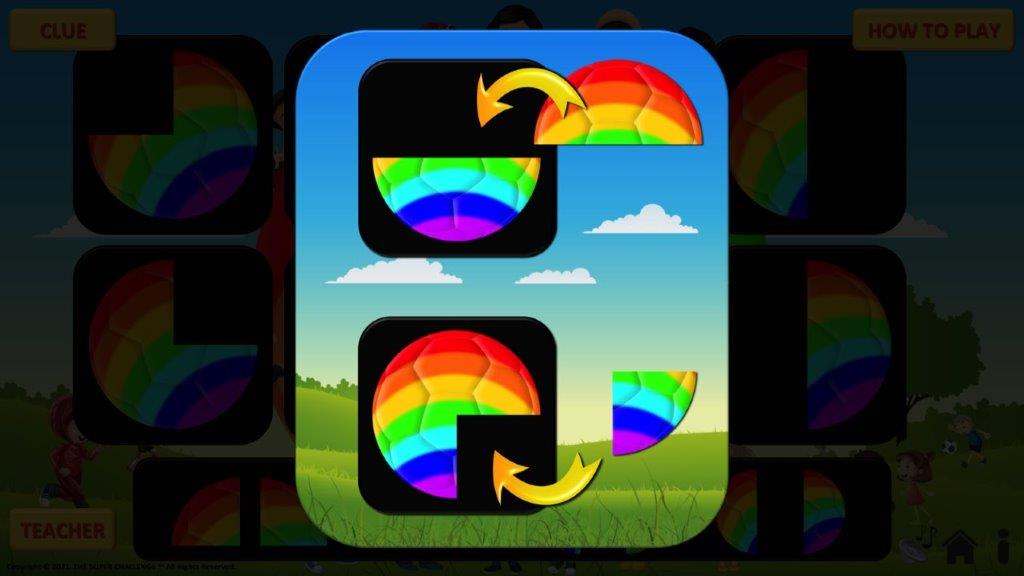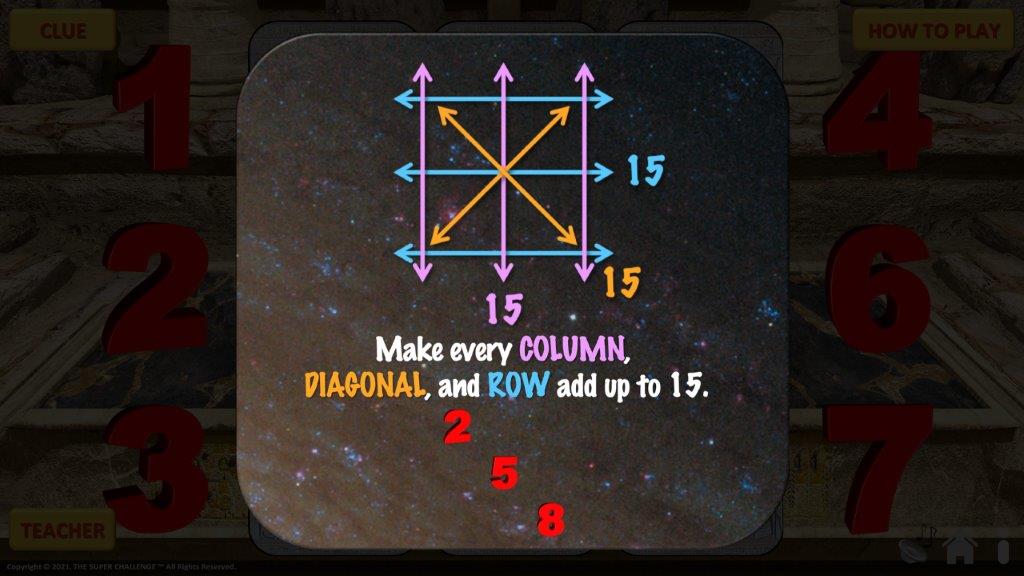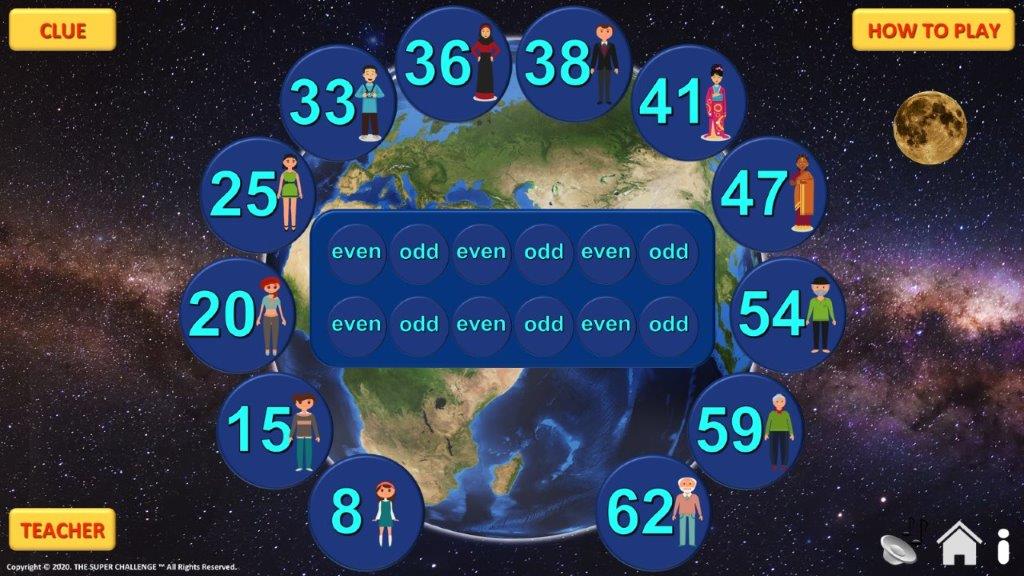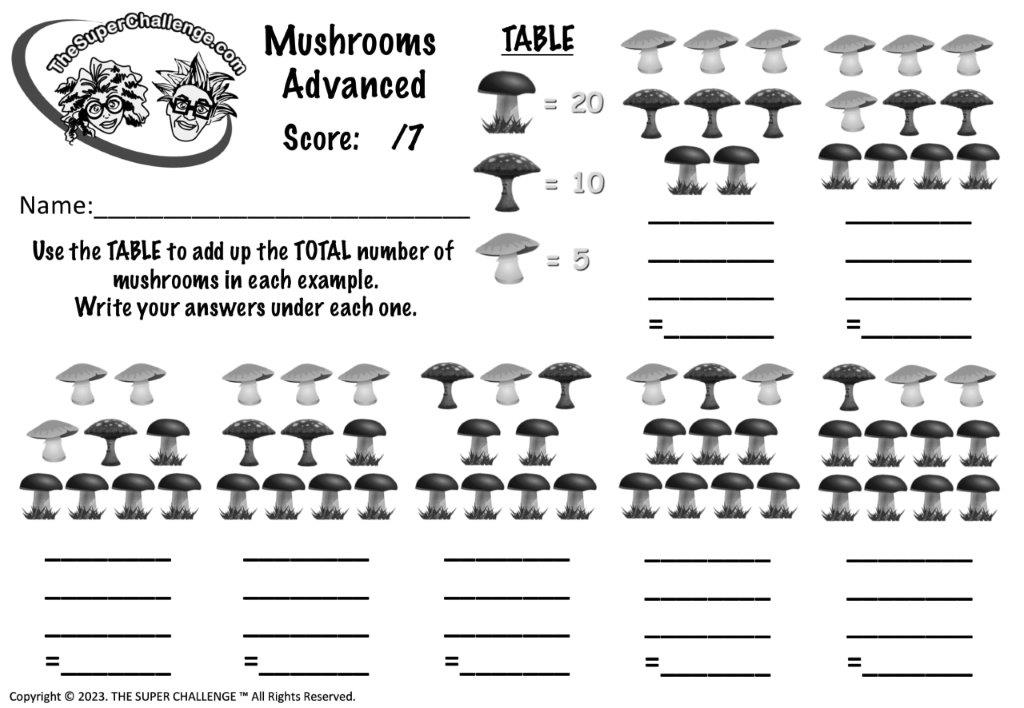YOUR SUPER CHALLENGE:
Your challenge is to complete any 5 games from YOUR grade level. You may do any combination of Mid-level or Advanced level games as long as they are of YOUR grade. A game is only completed when you finish all the questions in the game. You may try some games first to see which ones you would like to play. For games that have different versions, (Standard/Advanced, Money, Metric/Imperial etc), you only need to complete one of the versions. If you do other versions of the same game, it is still counted as only one game.
If you shut the game down, you will have to play from the start again. But if you write down your answers on the worksheet as you play, you can catch up to where you left the game. (The worksheet is optional.)
Once you have fully finished 5 different games, you have completed your challenge and may download your Certificate of Congratulations! But don’t stop there, challenge YOURSELF to see how many more games you can complete!
PARENTS & TUTORS:
The “Advanced Level” games are set at a level students aim to be at by the END of their school year. Also, games are not designed to be played on Safari browsers and may not load. All games may be played on PC’s & laptops; however, some may also be played on tablets, see the listing under each game name.
Warning: Games are not designed to be played using the Safari browsers.
Games should only be played using a web browser such as Chrome, Firefox or Microsoft Edge.
Please open this website using one of these browsers.
It is also advised you have the latest version of the Chrome, Firefox or Microsoft Edge web browsers.
Grade 3 – 4 Explained

CHEEKY FROG – STANDARD
GAME PLAYS ON: PC & LAPTOP ONLY
Cheeky Frog - Standard - Game Description
Ages: 8 – 9 years old
Suits: Grade 3 students in Australia, Third Grade students in the U.S.A. & Canada and Year 4 students in England.
Understanding simple addition.
This game helps students learn how to add two-digit numbers. It is the easier of the addition games for this level.
It is set at the zoo and students have a job counting frogs for the zookeeper. With sounds of nature including lots of frog sound effects, it is an engaging and fun way for students to learn. The game is full of positive and encouraging words to build mathematical confidence. It is designed to suit the Mathematics Curriculums of Australia, Canada, England and the U.S.A.
Teacher References:
(ACMMG061): Apply place value to partition, rearrange and regroup numbers to assist calculations and solve problems. Partitioning and regrouping numbers in terms of their usefulness for particular calculations.
Ref: Australian Curriculum Mathematics.
How To Play:
You work at the zoo and your job is to count frogs.
But they are being cheeky and keep jumping away!
Make sure you add them up correctly. Click on any SUM on the start page. You are given 4 choices but only 1 is correct.
Choose the correct TOTAL, (see the CLUE). Then DRAG your answer to the SUM above. You must check all the SUMS to finish the game! If you get 2 answers wrong in a row, the game RESTARTS! Are you ready for the challenge?
Cheeky Frog - Standard - Learning Outcomes

Cheeky Frog - Standard - Worksheet
CHEEKY FROG – ADVANCED
GAME PLAYS ON: PC & LAPTOP ONLY
Cheeky Frog - Advanced - Game Description
Ages: 8 – 9 years old
Suits: Grade 3 students in Australia, Third Grade students in the U.S.A. & Canada and Year 4 students in England.
Understanding more challenging addition problems.
This game helps students learn how to add two-digit numbers. It is the more challenging version of the Cheeky Frog addition games for this level.
It is set at the zoo and students have a job counting frogs for the zookeeper. With sounds of nature including lots of frog sound effects, it is an engaging and fun way for students to learn. The game is full of positive and encouraging words to build mathematical confidence. It is designed to suit the Mathematics Curriculums of Australia, Canada, England and the U.S.A.
Teacher References:
(ACMMG061): Apply place value to partition, rearrange and regroup numbers to assist calculations and solve problems. Partitioning and regrouping numbers in terms of their usefulness for particular calculations.
Ref: Australian Curriculum Mathematics.
How To Play:
You still work at the zoo counting frogs. Can you find an easy way to add them up? Do big numbers first, then add the smaller ones.
Click on any number. You are given 4 choices but only 1 is correct. Choose the correct SUM, (see the CLUE). Then DRAG your answer to the TOTAL above. You must check all the TOTALS to finish the game! If you get 2 answers wrong in a row, the game RESTARTS! Are you ready for the challenge?
Cheeky Frog – Advanced - Learning Outcomes

Cheeky Frog – Advanced - Worksheet
THE WIZARD
GAME PLAYS ON: PC & LAPTOP ONLY
The Wizard - Game Description
Ages: 8 – 9 years old
Suits: Grade 3 students in Australia, Third Grade students in the U.S.A. & Canada and Year 4 students in England.
Understanding addition and subtraction problems and the connection between them. Students are not permitted to use a calculator.
This game helps students learn how to subtract large numbers.
Students are helping an old wizard up a flight of 200 stairs. They must calculate how many stairs are left to reach the top. The game is fun with lots of wizard voice-overs and is full of positive and encouraging words to build mathematical confidence. It is designed to suit the Mathematics Curriculums of Australia, Canada, England and the U.S.A.
Teacher References:
(ACMNA055): Recall addition facts and related subtraction facts to develop increasingly efficient mental strategies for computation.
(ACMNA054): Recognise/Recognize and explain the connection between addition and subtraction.
Ref: Australian Curriculum Mathematics.
How To Play:
You are helping a kind old wizard up stairs to his castle door. There are 200 stairs in TOTAL. Along the way, he keeps asking you, how many stairs are left to go. Can you give him the correct answer? Click on one of the sets of stairs. Work out how many there are left to go. You are given 4 answer choices, but only 1 is correct. Choose the correct answer and DRAG it to the door above. Once you have done all the stairs correctly, you will have completed your challenge!
The Wizard - Learning Outcomes

The Wizard - Worksheet
AFRICA – METRIC
GAME PLAYS ON: PC, LAPTOP & TABLET
Africa – Metric - Game Description
Ages: 8 – 9 years old
Suits: Grade 3 students in Australia and Third Grade students in Canada.
Using common metric units of measurement, calculating the length and height of objects.
This game introduces students to metric units of measurement and converting from centimetres to metres. Students must also recall multiplication facts of ten. Students use pentominoes of different shapes to make 2 sized giraffes. They are then asked to calculate each giraffe’s height and length. It also introduces students to important concepts such as symmetry, area, and perimeter.
Set in an African jungle with lots of animal sounds, this is a fun and engaging game to play. Using the metric system, it is designed to suit the Mathematics Curriculums of Australia & Canada.
Teacher References:
(ACMMG061): Measure, order and compare objects using familiar metric units of length.
(ACMNA056): Recall multiplication facts of ten and related division facts.
Ref: Australian Curriculum Mathematics.
How To Play:
Can you make 2 giraffes? Different blue shapes appear one at a time. Use the shapes to cover up both giraffes.
First DRAG a shape out. You can FLIP or ROTATE pieces to make them fit. Each piece is made up of five equally sized squares. How tall is each giraffe? How long is each giraffe?
It’s tricky but don’t give up!
Africa – Metric - Learning Outcomes

Africa – Metric - Worksheet
AFRICA – IMPERIAL
GAME PLAYS ON: PC, LAPTOP & TABLET
Africa – Imperial - Game Description
Ages: 8 – 9 years old
Suits: Third Grade students in the U.S.A. and Year 4 students in England.
Using common imperial units of measurement, calculating the length and height of objects.
This game introduces students to imperial units of measurement. Students must also recall multiplication facts of ten. Students use pentominoes of different shapes to make 2 sized giraffes. They are then asked to calculate each giraffe’s height and length. It also introduces students to important concepts such as symmetry, area, and perimeter.
Set in an African jungle with lots of animal sounds, this is a fun and engaging game to play. Using the metric system, it is designed to suit the Mathematics Curriculums of the U.S.A. & England.
Teacher References:
(ACMMG061): Measure, order and compare objects using familiar (imperial) units of length.
(ACMNA056): Recall multiplication facts of ten and related division facts.
Ref: Australian Curriculum Mathematics.
How To Play:
Can you make 2 giraffes? Different blue shapes appear one at a time. Use the shapes to cover up both giraffes.
First DRAG a shape out. You can FLIP or ROTATE pieces to make them fit. Each piece is made up of five equally sized squares. How tall is each giraffe? How long is each giraffe?
It’s tricky but don’t give up!
Africa – Imperial - Learning Outcomes

Africa – Imperial - Worksheet
SWEET TOOTH
GAME PLAYS ON: PC, LAPTOP & TABLET
Sweet Tooth - Game Description
Ages: 8 – 9 years old
Suits: Grade 3 students in Australia, Third Grade students in the U.S.A. & Canada and Year 4 students in England
Identifying and describing possible outcomes in chance and recognising variation in results.
This is an educational mathematics game helping students understand “chance” and how to identify and describe possible outcomes. Students are asked to identify outcomes of events. They are asked to use everyday language such as ‘No chance’, ‘Unlikely’, ‘Even chance’, ‘Likely’ or ‘Certain’. Using lollipops in jars as examples, it makes chance very easy to understand and it is a very effective way for students to learn to describe outcomes. Fun to play and very engaging, it is designed to suit the Mathematics Curriculums of Australia, Canada, England and the U.S.A.
Teacher References:
(ACMSP067): Conduct chance experiments, identify and describe possible outcomes and recognise / recognize variation in results. Using language such as ‘No chance’, ‘Unlikely’, ‘Even chance’, ‘Likely’ or ‘Certain’. Conducting repeated trials of chance experiments such as tossing a coin or drawing a ball from a bag and identifying the variations between trials.
Ref: Australian Curriculum Mathematics.
How To Play:
Do you like lollipops? Here is a lollipop challenge for you! Can you pull out a blue lollipop? Imaging you close your eyes, then put your hand into one of the jars and mix all the lollipops up. You then pull one of them out. What is the chance of getting a blue one? You will be given 4 answer choices, but only 1 is correct! Choose one of the answers. Drag your answer to the yellow circle to see if you are correct. You will be challenged!
Sweet Tooth - Learning Outcomes

Sweet Tooth - Worksheet
BIRTHDAY
GAME PLAYS ON: PC, LAPTOP & TABLET
Birthday - Game Description
Ages: 8 – 9 years old
Suits: Grade 3 students in Australia, Third Grade students in the U.S.A. & Canada and Year 4 students in England.
Understanding fractions in a simple and effective way.
This game helps students to understand the concept of fractions. It is a very simple and effective way to demonstrate a difficult topic for this age level. Students must identify how many candles are blown out on a birthday cake. They are then asked to compare the number blown out to the total number of candles.
The game is also very encouraging as it is filled with positive sounds and voice-overs building mathematical confidence. It is designed to suit the Mathematics Curriculums of Australia, Canada, England and the U.S.A.
Teacher References:
(ACMNA058): Represent unit fractions including 1/2, 1/4, 1/3, 1/5 and their multiples to complete a whole. Recognising / Recognizing that the terms such as ‘one-third’ is used in order: numerator then denominator. Understanding fractions: 1/2, 1/4, 1/3, 1/5 and their multiples.
Ref: Australian Curriculum Mathematics.
How To Play:
It’s your dog’s birthday, so you made a cake! But she can only blow some of the candles out. How many candles are still on fire? Choose one of the cakes. Then choose correct answer and drag it to the circle. No guessing! You must get the answer correct on your first or second try, otherwise the GAME STARTS AGAIN! Are you ready for the challenge?
Birthday - Learning Outcomes

Birthday - Worksheet
TV GAME SHOW
GAME PLAYS ON: PC & LAPTOP ONLY
TV Game Show - Game Description
Ages: 8 – 9 years old
Suits: Grade 3 students in Australia, Third Grade students in the U.S.A. & Canada and Year 4 students in England.
Breaking down large numbers to assist addition.
This game helps students to understand addition of large numbers. It teaches students how to regroup and rearrange large numbers for easier calculations. It is a good gauge for teachers to judge how well a student grasps addition.
Set in a TV studio it is an exciting and fun game to play! It is full of positive and encouraging words to build mathematical confidence. The game is designed to suit the Mathematics Curriculums of Australia, Canada, England and the U.S.A.
Teacher References:
(ACMNA053): Apply place value to partition, rearrange and regroup numbers to at least 10 000 to assist calculations and solve problems.
Ref: Australian Curriculum Mathematics.
How To Play:
You are a contestant on a TV game show! To play, you have to match stars to numbers. Each star has points. You have to add them up! Click on any number and add the points up. You will be given 4 answers but only one answer is correct. Make your choice and drag your answer to the number above. To win the game, you must get them all correct! Don’t give up, you can do it!
TV Game Show - Learning Outcomes

TV Game Show - Worksheet
GROUPS OF FISH – STANDARD
GAME PLAYS ON: PC & LAPTOP ONLY
Groups of Fish - Standard - Game Description
Ages: 8 – 9 years old
Suits: Grade 3 students in Australia, Third Grade students in the U.S.A. & Canada and Year 4 students in England.
Learning simple multiplication facts of 2, 3, 5 & 10.
This is an educational mathematics game helping students grasp multiplication in preparation to understand division. Using fish in groups, students are asked to find totals without counting fish individually. It is a clear and easy way for students to grasp multiplication.
Set underwater with lots of fish and bubbles, it is a very calming game to play. It is also full of positive and encouraging words to build mathematical confidence. The game is designed to suit the Mathematics Curriculums of Australia, Canada, England and the U.S.A.
Teacher References:
(ACMNA056): Recall multiplication facts of two, three, five and ten and related division facts.
Ref: Australian Curriculum Mathematics.
How To Play:
You are looking underwater and counting fish. They are in groups. How many can you see? You must not count fish one at a time! Click on a number. You will be given 4 answers but only 1 answer is correct. Make your choice and drag your answer to the number above. You must get the answer correct on your first or second try or the GAME STARTS AGAIN! Are you ready for the challenge?
Groups of Fish – Standard - Learning Outcomes

Groups of Fish – Standard - Worksheet
GROUPS OF FISH – ADVANCED
GAME PLAYS ON: PC & LAPTOP ONLY
Groups of Fish - Advanced - Game Description
Ages: 8 – 9 years old
Suits: Grade 3 students in Australia, Third Grade students in the U.S.A. & Canada and Year 4 students in England.
Learning more challenging multiplication facts of 3, 5 & 10.
This is a more challenging multiplication game of facts of 3’s, 5’s and 10’s. Using fish in groups, students are asked to find totals without counting fish individually. It is a clear and easy way for students to grasp multiplication.
Set underwater with lots of fish and bubbles, it is a very calming game to play. It is also full of positive and encouraging words to build mathematical confidence. The game is designed to suit the Mathematics Curriculums of Australia, Canada, England and the U.S.A.
Teacher References:
(ACMNA056): Recall multiplication facts of two, three, five and ten and related division facts.
Ref: Australian Curriculum Mathematics.
How To Play:
You love to look underwater and count fish. They are in groups. How many can you see? Click on one of the groups of fish.
Only 1 of the 4 answers is correct. DRAG your answer to the fish above. Are you good at multiplication? See the CLUE. It is very important to learn your times tables. Are you ready for this challenge?
Groups of Fish – Advanced - Learning Outcomes

Groups of Fish – Advanced - Worksheet
CITY LOCATIONS
GAME PLAYS ON: PC, LAPTOP & TABLET
City Locations - Game Description
Ages: 8 – 9 years old
Suits: Grade 3 students in Australia, Third Grade students in the U.S.A. & Canada and Year 4 students in England.
Interpreting simple grid maps to show position as a basis for understanding map reading and ordered pairs.
This game helps students understand how to read and interpret a grid. It is a very simple and effective way to demonstrate map reading. The importance of reading a map of a city is used as an example. It is also a very clear and simple way for students to understand ordered pairs.
The game is very engaging to play as it is full of exciting sounds in an imaginative setting. It is designed to suit the Mathematics Curriculums of Australia, Canada, England and the U.S.A.
Teacher References:
(ACMMG065): Interpret simple grid maps to show position.
Ref: Australian Curriculum Mathematics.
How To Play:
Cities are very big places with lots of streets. Being able to read a city map is very important. It’s not hard, it’s just a grid. If you can read a grid, you can read a city map. Can you read a map of a city? Let’s find out! As pieces appear, put them onto their correct positions on the grid. Do this until you have done them all! Make sure you drag each one carefully. If you get two answers wrong, you must START AGAIN! Are you ready for the challenge?
City Locations - Learning Outcomes

City Locations - Worksheet
THE BALL
GAME PLAYS ON: PC, LAPTOP & TABLET
The Ball - Game Description
Ages: 8 – 9 years old
Suits: Grade 3 students in Australia, Third Grade students in the U.S.A. & Canada and Year 4 students in England.
Identifying one-half and one-quarter.
Designed for students struggling with understanding simple fractions, this game demonstrates one-half and one-quarter.
Set at an amusement park with a huge ball. The ball is in pieces of halves and quarters and students have fun putting the ball back together. The game is very engaging to play as it is full of exciting sounds in an imaginative setting. It is designed to suit the Mathematics Curriculums of Australia, Canada, England and the U.S.A.
Teacher References:
(ACMA058): Model and represent unit fractions and their multiples to a complete whole. This game is for beginners to understand the unit fractions of 1/2 & 1/4.
Ref: Australian Curriculum Mathematics.
How To Play:
You are going to an amusement park that has the biggest ball in the world! To get in the park, you must complete this challenge! The ball is in pieces. Can you make each ball whole again? Are you ready for the challenge?
The Ball - Learning Outcomes

The Ball - Worksheet
COMIC BOOKS – AUSTRALIA
GAME PLAYS ON: PC & LAPTOP ONLY
Comic Books – Australia - Game Description
Ages: 8 – 9 years old
Suits: Grade 3 students in Australia.
Regrouping numbers to assist calculations & solve problems.
This game helps students understand regrouping and rearranging numbers to assist with calculations. Students must calculate answers using Australian banknotes. Students are taught to recognise 10 000 equals 10 thousands, 100 hundreds, 1000 tens or 10 000 ones. It helps students make correct choices to partition and regroup numbers in terms of their usefulness for particular calculations.
The game has a double benefit as it uses banknotes for students to count. It is based on super-heroes and is exciting to play, making mathematics fun. It is designed to suit the Mathematics Curriculum of Australia.
Teacher References:
(ACMNA053): Apply place value to partition, rearrange and regroup numbers to at least 10 000 to assist calculations and solve problems.
Ref: Australian Curriculum Mathematics.
How To Play:
You have been given rare and valuable comic books and you have put them up for sale. Make sure you are given the correct amount of money! Click on any comic book. Choose the correct amount of money, (see the CLUE). Then DRAG your answer to the total above. No guessing! You must get the answer correct on your first or second try, or the GAME STARTS AGAIN!
Comic Books – Australia - Learning Outcomes

Comic Books – Australia - Worksheet
COMIC BOOKS – CANADA
GAME PLAYS ON: PC & LAPTOP ONLY
Comic Books – Canada - Game Description
Ages: 8 – 9 years old
Suits: Third Grade students in Canada.
Regrouping numbers to assist calculations & solve problems.
This game helps students understand regrouping and rearranging numbers to assist with calculations. Students must calculate answers using Canadian banknotes. Students are taught to recognize 10 000 equals 10 thousands, 100 hundreds, 1000 tens or 10 000 ones. It helps students make correct choices to partition and regroup numbers in terms of their usefulness for particular calculations.
The game has a double benefit as it uses banknotes for students to count. It is based on super-heroes and is exciting to play, making mathematics fun. It is designed to suit the Mathematics Curriculum of Canada.
Teacher References:
(ACMNA053): Apply place value to partition, rearrange and regroup numbers to at least 10 000 to assist calculations and solve problems.
Ref: Australian Curriculum Mathematics.
How To Play:
You have been given rare and valuable comic books and you have put them up for sale. Make sure you are given the correct amount of money! Click on any comic book. Choose the correct amount of money, (see the CLUE). Then DRAG your answer to the total above. No guessing! You must get the answer correct on your first or second try, or the GAME STARTS AGAIN!
Comic Books – Canada - Learning Outcomes

Comic Books – Canada - Worksheet
COMIC BOOKS – ENGLAND
GAME PLAYS ON: PC & LAPTOP ONLY
Comic Books – England - Game Description
Ages: 8 – 9 years old
Suits: Year 4 students in England.
Regrouping numbers to assist calculations & solve problems.
This game helps students understand regrouping and rearranging numbers to assist with calculations. Students must calculate answers using British banknotes. Students are taught to recognise 10 000 equals 10 thousands, 100 hundreds, 1000 tens or 10 000 ones. It helps students make correct choices to partition and regroup numbers in terms of their usefulness for particular calculations.
The game has a double benefit as it uses banknotes for students to count. It is based on super-heroes and is exciting to play, making mathematics fun. It is designed to suit the Mathematics Curriculum of England.
Teacher References:
(ACMNA053): Apply place value to partition, rearrange and regroup numbers to at least 10 000 to assist calculations and solve problems.
Ref: Australian Curriculum Mathematics.
How To Play:
You have been given rare and valuable comic books and you have put them up for sale. Make sure you are given the correct amount of money! Click on any comic book. Choose the correct amount of money, (see the CLUE). Then DRAG your answer to the total above. No guessing! You must get the answer correct on your first or second try, or the GAME STARTS AGAIN!
Comic Books – England - Learning Outcomes

Comic Books – England - Worksheet
COMIC BOOKS – USA
GAME PLAYS ON: PC & LAPTOP ONLY
Comic Books – U.S.A. - Game Description
Ages: 8 – 9 years old
Suits: Third Grade students in the U.S.A.
Regrouping numbers to assist calculations & solve problems.
This game helps students understand regrouping and rearranging numbers to assist with calculations. Students must calculate answers using U.S.A. banknotes. Students are taught to recognize 10 000 equals 10 thousands, 100 hundreds, 1000 tens or 10 000 ones. It helps students make correct choices to partition and regroup numbers in terms of their usefulness for particular calculations.
The game has a double benefit as it uses banknotes for students to count. It is based on super-heroes and is exciting to play, making mathematics fun. It is designed to suit the Mathematics Curriculum of the U.S.A.
Teacher References:
(ACMNA053): Apply place value to partition, rearrange and regroup numbers to at least 10 000 to assist calculations and solve problems.
Ref: Australian Curriculum Mathematics.
How To Play:
You have been given rare and valuable comic books and you have put them up for sale. Make sure you are given the correct amount of money! Click on any comic book. Choose the correct amount of money, (see the CLUE). Then DRAG your answer to the total above. No guessing! You must get the answer correct on your first or second try, or the GAME STARTS AGAIN!
Comic Books – USA - Learning Outcomes
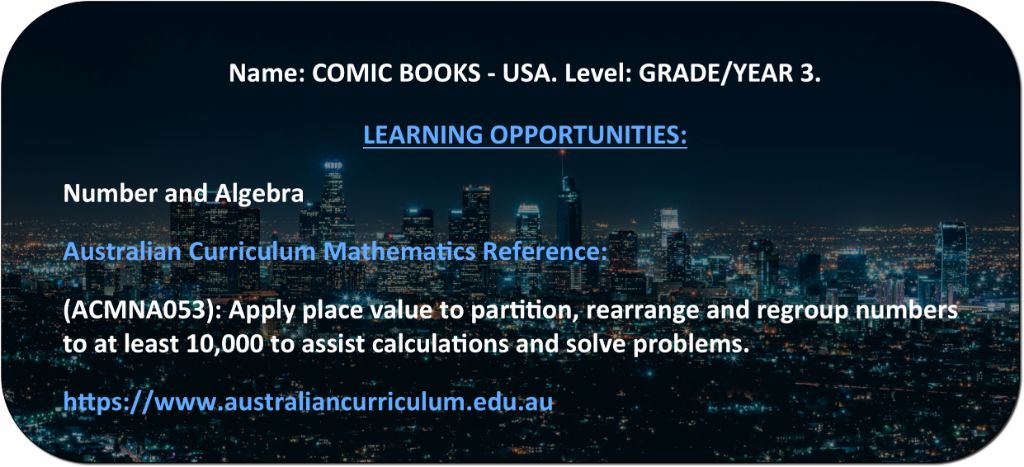
Comic Books – USA - Worksheet
NOODLES – AUSTRALIA
GAME PLAYS ON: PC & LAPTOP ONLY
Noodles – Australia - Game Description
Ages: 8 – 9 years old
Understanding money denominations to assist with calculations and correct change.
Suits: Grade 3 students in Australia.
This is an educational mathematics game helping students understand money values and how to count the change required for simple transactions to the nearest five cents. It also helps students recognise the relationship between dollars and cents.
As there are 3 other versions of this game including English, Canadian and American versions, so it also helps students to note that countries use their own denominations. The game is full of positive and encouraging words to build mathematical confidence. It is designed to suit the Mathematics Curriculum of Australia.
Teacher References:
(ACMNA059): Represent money values in multiple ways and count the change required for simple transactions to the nearest five cents. Recognising the relationship between dollars and cents, and that not all countries use these denominations and divisions.
Ref: Australian Curriculum Mathematics.
How To Play:
The school canteen is now serving noodles! You have $10 to spend on each bowl. Can you work out how much change you should get? Only one of the 4 answers given is correct. Which one is it? Drag your answer to the bowl of noodles above. You must get the answer correct on your first or second try, otherwise, the GAME STARTS AGAIN!
Noodles – Australia - Learning Outcomes
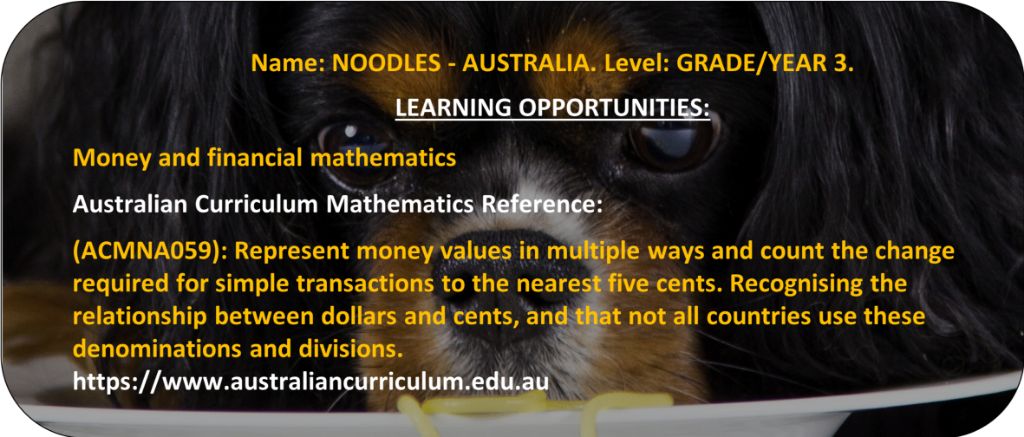
Noodles – Australia - Worksheet
NOODLES – CANADA
GAME PLAYS ON: PC & LAPTOP ONLY
Noodles – Canada - Game Description
Ages: 8 – 9 years old
Understanding money denominations to assist with calculations and correct change.
Suits: Third Grade students in Canada.
This is an educational mathematics game helping students understand money values and how to count the change required for simple transactions to the nearest five cents. It also helps students recognize the relationship between dollars and cents.
As there are 3 other versions of this game including Australian, English and American versions, so it also helps students to note that countries use their own denominations. The game is full of positive and encouraging words to build mathematical confidence. It is designed to suit the Mathematics Curriculum of Canada.
Teacher References:
(ACMNA059): Represent money values in multiple ways and count the change required for simple transactions to the nearest five cents. Recognizing the relationship between dollars and cents, and that not all countries use these denominations and divisions.
Ref: Australian Curriculum Mathematics.
How To Play:
The school canteen is now serving noodles! You have $10 to spend on each bowl. Can you work out how much change you should get? Only one of the 4 answers given is correct. Which one is it? Drag your answer to the bowl of noodles above. You must get the answer correct on your first or second try, otherwise, the GAME STARTS AGAIN!
Noodles – Canada - Learning Outcomes

Noodles – Canada - Worksheet
NOODLES – ENGLAND
GAME PLAYS ON: PC & LAPTOP ONLY
Noodles – England - Game Description
Ages: 8 – 9 years old
Understanding money denominations to assist with calculations and correct change.
Suits: Year 4 students in England.
This is an educational mathematics game helping students understand money values and how to count the change required for simple transactions to the nearest five pence. It also helps students recognise the relationship between pounds and pence.
As there are 3 other versions of this game including Australian, Canadian and American versions, so it also helps students to note that countries use their own denominations. The game is also full of positive and encouraging words to build mathematical confidence. It is designed to suit the Mathematics Curriculum of England.
Teacher References:
(ACMNA059): Represent money values in multiple ways and count the change required for simple transactions…
Ref: Australian Curriculum Mathematics.
How To Play:
The school canteen is now serving noodles! You have 10 pounds to spend on each bowl. Can you work out how much change you should get? Only one of the 4 answers given is correct. Which one is it? Drag your answer to the bowl of noodles above. You must get the answer correct on your first or second try, otherwise, the GAME STARTS AGAIN!
Noodles – England - Learning Outcomes
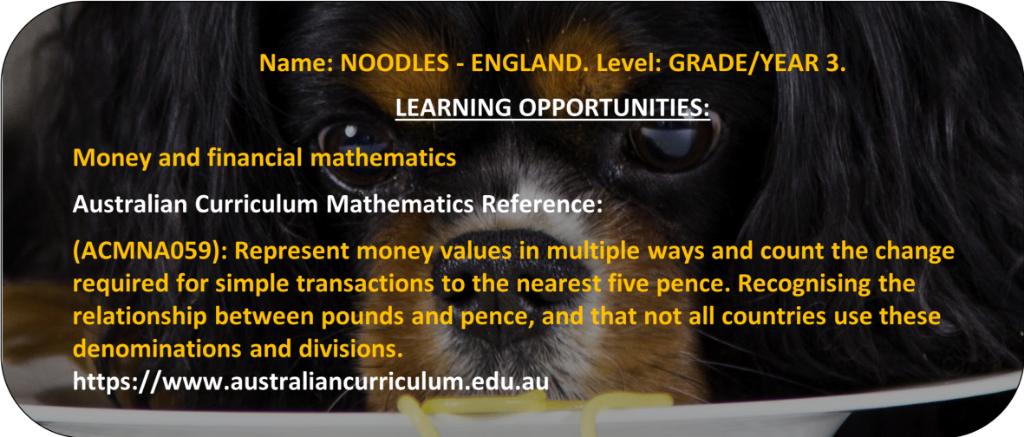
Noodles – England - Worksheet
NOODLES – USA
GAME PLAYS ON: PC & LAPTOP ONLY
Noodles – U.S.A. - Game Description
Ages: 8 – 9 years old
Understanding money denominations to assist with calculations and correct change.
Suits: Third Grade students in the U.S.A.
This is an educational mathematics game helping students understand money values and how to count the change required for simple transactions to the nearest five cents. It also helps students recognize the relationship between dollars and cents.
As there are 3 other versions of this game including Australian, Canadian and English versions, so it also helps students to note that countries use their own denominations. The game is full of positive and encouraging words to build mathematical confidence. It is designed to suit the Mathematics Curriculum of the U.S.A.
Teacher References:
(ACMNA059): Represent money values in multiple ways and count the change required for simple transactions to the nearest five cents. Recognizing the relationship between dollars and cents, and that not all countries use these denominations and divisions.
Ref: Australian Curriculum Mathematics.
How To Play:
The school canteen is now serving noodles! You have $10 to spend on each bowl. Can you work out how much change you should get? Only one of the 4 answers given is correct. Which one is it? Drag your answer to the bowl of noodles above. You must get the answer correct on your first or second try, otherwise, the GAME STARTS AGAIN!
Noodles – USA - Learning Outcomes

Noodles – USA - Worksheet
CORNERS EDGES AND FACES
GAME PLAYS ON: PC & LAPTOP ONLY
Corners Edges and Faces - Game Description
Ages: 8 – 9 years old
Suits: Grade 3 students in Australia, Third Grade students in the U.S.A. & Canada and Year 4 students in England.
Learning how to identify and describe geometric features of three-dimensional objects.
This is an educational mathematics game exploring three-dimensional objects. Students learn to identify key features of shapes and objects such as the number of corners, edges and faces.
Set in ancient Egypt with fascinating sound effects it is an exciting and very engaging way for students to learn. This game is designed to suit the Mathematics Curriculums of Australia, Canada, England and the U.S.A.
Teacher References:
(ACMMG063): Make models of three-dimensional objects and describe key features. Identifying geometric features such as the number of ‘corners’, ‘edges’ and ‘faces’.
Ref: Australian Curriculum Mathematics.
How To Play:
You are on holiday in Egypt, and you visit the pyramids often. It makes you wonder how they were made! The builders must have been masters of shapes. Do you know your shapes? How many CORNERS, EDGES or FACES do shapes have? Click on a shape. Choose the correct answer. Then drag your answer to the shape above. Your answer must be the TOTAL number for each shape. To complete your challenge: Can you make a pyramid out of paper?
Corners Edges and Faces - Learning Outcomes

Corners Edges and Faces - Worksheet
THE JINX
GAME PLAYS ON: PC, LAPTOP & TABLET
The Jinx - Game Description
Ages: 8 – 9 years old
Suits: Grade 3 students in Australia, Third Grade students in the U.S.A. & Canada and Year 4 students in England.
Understanding single-digit number combinations for addition and subtraction in preparation of computations of larger numbers.
This is an educational mathematics game preparing students for addition and subtraction of large numbers. It helps students understand that certain single-digit number combinations for addition and subtraction always result in the same answer. Students may then use this knowledge for addition and subtraction of larger numbers. It teaches students how to regroup and rearrange large numbers for easier calculations.
Set in Egypt with Middle Eastern music tracks and sounds it is a very engaging and fun game to play! The challenge is for students to solve a tricky number puzzle that has many different possible combinations. The game is designed to suit the Mathematics Curriculums of Australia, Canada, England and the U.S.A.
Teacher References:
(ACMNA055): Recall addition facts for single-digit numbers to develop increasingly efficient mental strategies for computation. Recognising / Recognizing that certain single-digit number combinations always result in the same answer for addition and subtraction and using this knowledge for addition and subtraction of larger numbers.
Ref: Australian Curriculum Mathematics.
How To Play:
You have accidentally disturbed an ancient mummy and a jinx has been placed on you! You need to complete the puzzle to lift the jinx. Put numbers into the grid so every line will add up to 15. See the CLUE for help! Once you complete this challenge, the jinx will be lifted! Good luck!
The Jinx - Learning Outcomes
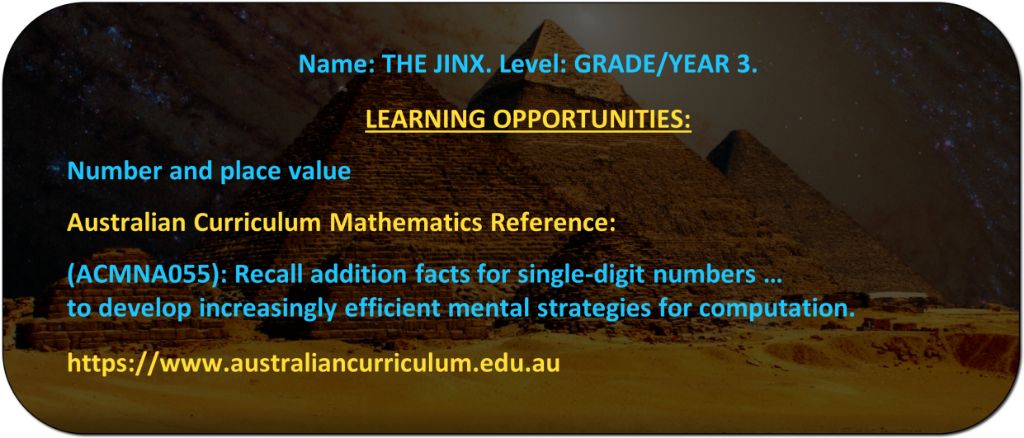
The Jinx - Worksheet
PENGUIN CHICKS – STANDARD
GAME PLAYS ON: PC & LAPTOP ONLY
Penguin Chicks - Standard - Game Description
Ages: 8 – 9 years old
Suits: Grade 3 students in Australia, Third Grade students in the U.S.A. & Canada and Year 4 students in England.
Understanding simple addition and subtraction.
This game helps students learn how to add and subtract and the connection between them. It is the easier of two Penguin Chicks addition and subtraction games for this level.
It is set in Antarctica with sounds of penguins and their chicks. It is an engaging way for students to learn and is full of positive and encouraging words to build mathematical confidence. It is designed to suit the Mathematics Curriculums of Australia, Canada, England and the U.S.A.
Teacher References:
(ACMNA054): Recognise / Recognize and explain the connection between addition and subtraction. Demonstrating the connection between addition and subtraction using partitioning or by writing equivalent number sentences.
(ACMNA055): Recall addition facts and related subtraction facts to develop increasingly efficient mental strategies for computation. This game includes numbers to 100. For numbers to 1000, see the game EXPEDITION.
Ref: Australian Curriculum Mathematics.
How To Play:
Your job on a scientific expedition is to count penguin chicks. You have counted them in groups. You must add them up to get the TOTALS. Click on one of the TOTALS on the start page. Choose the correct answer and drag it to the TOTAL. No calculator! You must get the answer correct on your first or second try or the GAME STARTS AGAIN! Are you ready for the challenge?
Penguin Chicks – Standard - Learning Outcomes

Penguin Chicks – Standard - Worksheet
PENGUIN CHICKS – ADVANCED
GAME PLAYS ON: PC & LAPTOP ONLY
Penguin Chicks- Advanced - Game Description
Ages: 8 – 9 years old
Suits: Grade 3 students in Australia, Third Grade students in the U.S.A. & Canada and Year 4 students in England.
Understanding more complex addition and subtraction for this level.
This game is the more challenging addition and subtraction game for this age group. It helps students learn how to add and subtract and the connection between them.
It is set in Antarctica with sounds of penguins and their chicks. It is an engaging way for students to learn and is full of positive and encouraging words to build mathematical confidence. It is designed to suit the Mathematics Curriculums of Australia, Canada, England and the U.S.A.
Teacher References:
(ACMNA054): Recognise / recognize and explain the connection between addition and subtraction. Demonstrating the connection between addition and subtraction using partitioning or by writing equivalent number sentences.
(ACMNA055): Recall addition facts and related subtraction facts to develop increasingly efficient mental strategies for computation. This game includes numbers to 100. For numbers to 1000, see the game EXPEDITION.
Ref: Australian Curriculum Mathematics.
How To Play:
You have been promoted to chief recorder on the scientific expedition. Now you must count all penguin chicks. Once again you have counted them in groups, but you must check you have added them up correctly. Click on one of the SUMS on the start page. Choose the correct answer and drag it to the SUM. No calculator! You must get the answer correct on your first or second try or the GAME STARTS AGAIN! Are you ready for the challenge?
Penguin Chicks - Advanced - Learning Outcomes

Penguin Chicks - Advanced - Worksheet
ODDS AND EVENS
GAME PLAYS ON: PC, LAPTOP & TABLET
Odds and Evens - Game Description
Ages: 8 – 9 years old
Suits: Grade 3 students in Australia, Third Grade students in the U.S.A. & Canada and Year 4 students in England.
Identifying characteristics of odd and even numbers.
This game helps students to identify that numbers ending in the digits 0, 2, 4, 6 and 8 are even and that numbers ending in 1, 3, 5, 7 and 9 are odd. This game has three levels of difficulty. By the time a student is ready to play the most challenging part C, they will have a good understanding of what makes a number even or odd.
Using people of different ages and cultures as examples, it is a fun game to play. This game is designed to suit the Mathematics Curriculums of Australia, Canada, England and the U.S.A.
Teacher References:
(ACMNA051): Investigate the conditions required for a number to be odd or even and identify odd and even numbers. Explain why all numbers that end in the digits 0, 2, 4, 6 and 8 are even and that numbers ending in 1, 3, 5, 7 and 9 are odd. Part C is challenging and a good gauge for teacher to see how well a student understands the characteristics of odd and even numbers.
Ref: Australian Curriculum Mathematics.
How To Play:
Numbers are used all around the world and in every culture. But what makes a number EVEN or ODD? People of different ages will appear. Which numbers are EVEN and which are ODD? Drag your answers onto the blue circles. Then click the blue box to see if you are correct. Challenge: Then can you do it with large numbers? Are you ready for your challenge?
Odds and Evens - Learning Outcomes

Odds and Evens - Worksheet
ADD THREE IN-LINE
GAME PLAYS ON: PC, LAPTOP & TABLET
Add Three In-Line - Game Description
Ages: 8 – 9 years old
Suits: Grade 3 students in Australia, Third Grade students in the U.S.A. & Canada and Year 4 students in England.
Understanding simple double-digit number combinations for addition.
This is an educational mathematics game preparing students for addition of large numbers. It helps students learn that certain single-digit number combinations for addition and subtraction always result in the same answer. Students may then use this knowledge for addition and subtraction of double-digit numbers. This game uses multiples of tens, introducing students to double-digit addition.
The challenge is for students to solve a tricky number puzzle that has many different possible combinations. It uses exciting sound effects making it a very engaging and fun game to play! The game is designed to suit the Mathematics Curriculums of Australia, Canada, England and the U.S.A.
Teacher References:
(ACMNA055): Recall addition facts for single-digit numbers to develop increasingly efficient mental strategies for computation. Recognising / Recognizing that certain single-digit number combinations always result in the same answer for addition and subtraction and using this knowledge for addition and subtraction of larger numbers.
Ref: Australian Curriculum Mathematics.
How To Play:
Number 50 will appear in the middle circle. Then DRAG each number into the outer blue circles. Every arrow must add up to a TOTAL of 150. Then your challenge is next! Number 40 will appear in the middle circle. Now can you make every arrow add up to a TOTAL of 120? Good luck!
Add Three In-Line - Learning Outcomes

Add Three In-Line - Worksheet
QUIZ SHOW – STANDARD
GAME PLAYS ON: PC, LAPTOP & TABLET
Quiz Show- Standard - Game Description
Ages: 8 – 9 years old
Suits: Grade 3 students in Australia, Third Grade students in the U.S.A. & Canada and Year 4 students in England.
Learning to solve subtraction problems with large numbers.
This game helps students learn how to solve subtraction problems that involve large numbers for this age group. It is the more challenging subtraction game for this level and a good gauge for teachers to judge how well a student understands subtraction.
Set on a TV quiz show, students must solve subtraction problems as if they are on TV and competing to win the game. It is an engaging game full of exciting TV studio sounds and is also full of positive and encouraging words to build mathematical confidence. This game is designed to suit the Mathematics Curriculums of Australia, Canada, England and the U.S.A.
Teacher References:
(ACMNA054): Recognise / Recognize and explain the connection between addition and subtraction. Demonstrating the connection between addition and subtraction using partitioning or by writing equivalent number sentences.
(ACMNA055): Recall addition facts and related subtraction facts to develop increasingly efficient mental strategies for computation.
Ref: Australian Curriculum Mathematics.
How To Play:
You are on a TV QUIZ SHOW! You have to work out the answer to each quiz. Choose your answer from the numbers given. Then drag your answer onto the yellow circle. Once you have done all of the first round, your challenge will appear. If you complete the whole quiz, you win the game! Are you prepared for your challenge?
Quiz Show – Standard - Learning Outcomes

Quiz Show – Standard - Worksheet
QUIZ SHOW – ADVANCED
GAME PLAYS ON: PC, LAPTOP & TABLET
Quiz Show- Advanced - Game Description
Ages: 8 – 9 years old
Suits: Grade 3 students in Australia, Third Grade students in the U.S.A. & Canada and Year 4 students in England.
Learning to solve more complex subtraction problems with large numbers.
This game is the more challenging of the two Quiz show games. It includes more difficult subtraction problems but is still within the capabilities of most students. As with all advanced version games, students are not expected to be able to complete the game until the end of the school year. This game is a good gauge for teachers to judge how well a student understands subtraction.
Set on a TV quiz show, students must solve subtraction problems as if they are on TV and competing to win the game. It is an engaging game full of exciting TV studio sounds and is also full of positive and encouraging words to build mathematical confidence. This game is designed to suit the Mathematics Curriculums of Australia, Canada, England and the U.S.A.
Teacher References:
(ACMNA054): Recognise / Recognize and explain the connection between addition and subtraction. Demonstrating the connection between addition and subtraction using partitioning or by writing equivalent number sentences.
(ACMNA055): Recall addition facts and related subtraction facts to develop increasingly efficient mental strategies for computation.
Ref: Australian Curriculum Mathematics.
How To Play:
You are now in the finals on a TV QUIZ SHOW! To win you must answer each quiz. Choose your answer from the numbers given. Then drag your answer onto the yellow circle. Once you have done all the first round, your challenge will appear. If you complete the whole quiz, you win the final! Are you prepared for your challenge?
Quiz Show - Advanced - Learning Outcomes

Quiz Show - Advanced - Worksheet
OUTER SPACE – STANDARD
GAME PLAYS ON: PC & LAPTOP ONLY
Outer Space - Standard - Game Description
Ages: 8 – 9 years old
Suits: Grade 3 students in Australia, Third Grade students in the U.S.A. & Canada and Year 4 students in England.
Learning to tell time to the minute and how to convert between hours, minutes and seconds.
This is an educational mathematics game helping students to investigate and understand the relationship between units of time. Students learn to identify that there are 60 minutes in an hour and 60 seconds in a minute. Set in outer space with fascinating sound effects it is an exciting and very engaging way for students to learn time. This is particularly important as time is often a difficult concept for students of this age to grasp.
The game is also very encouraging as it is filled with positive words building mathematical confidence. It is designed to suit the Mathematics Curriculums of Australia, Canada, England and the U.S.A.
Teacher References:
(ACMMG062): Tell time to the minute and investigate the relationship between units of time, (60 minutes in an hour and 60 seconds in a minute).
Ref: Australian Curriculum Mathematics.
How To Play:
You are the pilot of a spacecraft traveling through time. But your ship is about to be sucked into a wormhole! How much time do you have left? Can you steer the ship away? Choose the correct time to save the ship! Click on any of the clocks. Which time is correct? Choose the correct answer. Then drag your answer to the clock above. You must get the answer correct on your first or second try, otherwise, the GAME STARTS AGAIN, and ship will be lost!
Outer Space - Standard - Learning Outcomes
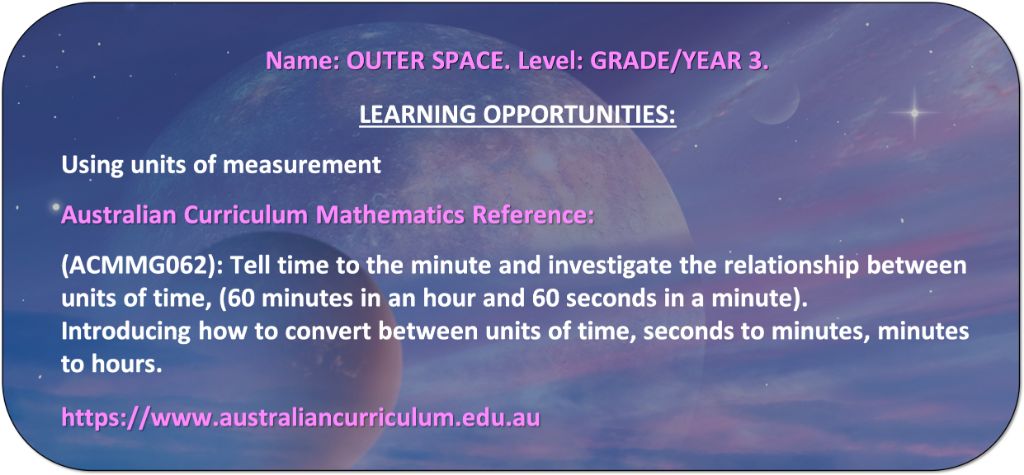
Outer Space - Standard - Worksheet
OUTER SPACE – ADVANCED
GAME PLAYS ON: PC & LAPTOP ONLY
Outer Space - Advanced - Game Description
Ages: 8 – 9 years old
Suits: Grade 3 students in Australia, Third Grade students in the U.S.A. & Canada and Year 4 students in England.
More challenging conversion between hours, minutes and seconds.
This is the more challenging game for students to convert units of time. Students learn to identify that there are 60 minutes in an hour and 60 seconds in a minute. Set in outer space with fascinating sound effects it is an exciting and very engaging way for students to learn time.
The game is also very encouraging as it is filled with positive words building mathematical confidence. It is designed to suit the Mathematics Curriculums of Australia, Canada, England and the U.S.A.
Teacher References:
(ACMMG062): Tell time to the minute and investigate the relationship between units of time, (60 minutes in an hour and 60 seconds in a minute).
Ref: Australian Curriculum Mathematics.
How To Play:
You are the pilot of a spacecraft and are about to land on an alien planet. You need to add up time to start the landing. Click on any of the clocks. Add the 2 times together. Choose the correct answer, see the CLUE. Then DRAG your answer to the clock above. You must complete all of the times to land the ship!
If you get 2 answers wrong in a row, the game restarts!
Outer Space - Advanced - Learning Outcomes

Outer Space - Advanced - Worksheet
MISSING AGES
GAME PLAYS ON: PC, LAPTOP & TABLET
Missing Ages - Game Description
Ages: 8 – 9 years old
Suits: Grade 3 students in Australia, Third Grade students in the U.S.A. & Canada and Year 4 students in England
Counting by 6, 7, 8 & 9’s and identifying number patterns.
This is an educational mathematics game helping students understand number patterns. Students are given the ages of people from different cultures from around the world and then asked to identify the missing ages of people in each number pattern.
Number patterns include counting by 6, 7, 8 & 9. Fun to play and very engaging, it is designed to suit the Mathematics Curriculums of Australia, Canada, England and the U.S.A.
Teacher References:
(ACMNA060): Describe, continue, and create number patterns resulting from performing addition or subtraction. Identifying and writing the rules for number patterns.
Ref: Australian Curriculum Mathematics.
How To Play:
People of different cultures and of different ages will appear. Put people in ORDER from youngest to oldest. In the first set, each age goes up by 6 years at a time. Can you see a pattern? There are 3 people whose age is not known. Can you work out the ages that are missing in the number pattern? Then ages go up by 7, 8 and 9 years at a time. Can you do each one?
Missing Ages - Learning Outcomes

Missing Ages - Worksheet
WRIST WATCH 1
GAME PLAYS ON: PC & LAPTOP ONLY
Wrist Watch 1 - Game Description
Ages: 8 – 9 years old
Suits: Grade 3 students in Australia, Third Grade students in the U.S.A. & Canada and Year 4 students in England.
This game is focused on analogue clocks. Learning to tell time to the minute and how to convert between hours, minutes, and seconds.
This game helps students to investigate and understand the relationship between units of time. Students learn to identify that there are 60 minutes in an hour and 60 seconds in a minute. Set at a skateboard park with lots of fun sound effects it is an engaging way for students to learn time.
The game is also very encouraging as it is filled with positive words building mathematical confidence. It is designed to suit the Mathematics Curriculums of Australia, Canada, England and the U.S.A.
Teacher References:
(ACMMG062): Tell time to the minute and investigate the relationship between units of time. Identifying there are 60 minutes in an hour and 60 seconds in a minute.
This game has time measurements in 5-minute units. For time measurements to the minute, see the game OUTER SPACE.
Ref: Australian Curriculum Mathematics.
How To Play:
Your friends always meet you at the skateboard park. But every weekend you go at different times. You must learn how to read the time so you can meet them. You have been given a watch.
Choose one of the times on the watch and click on it. Only 1 of the 4 answers is the correct time. Choose the correct answer and DRAG it to the watch above! Keep doing this until you have done them all. If you get 2 answers wrong in a row, the game will RESTART!
Wrist Watch 1 - Learning Outcomes

Wrist Watch 1 - Worksheet
WRIST WATCH 2
GAME PLAYS ON: PC & LAPTOP ONLY
Wrist Watch 2 - Game Description
Ages: 8 – 9 years old
Suits: Grade 3 students in Australia, Third Grade students in the U.S.A. & Canada and Year 4 students in England.
This game is focused on converting analogue clock times to digital clock times. Learning to tell time to the minute and how to convert between hours, minutes, and seconds.
This game helps students to investigate and understand the relationship between units of time. Students learn to identify that there are 60 minutes in an hour and 60 seconds in a minute. Set at a skateboard park with lots of fun sound effects it is an engaging way for students to learn time.
The game is also very encouraging as it is filled with positive words building mathematical confidence. It is designed to suit the Mathematics Curriculums of Australia, Canada, England and the U.S.A.
Teacher References:
(ACMMG062): Tell time to the minute and investigate the relationship between units of time. Identifying there are 60 minutes in an hour and 60 seconds in a minute.
This game has time measurements in 5-minute units. For time measurements to the minute, see the game OUTER SPACE.
Ref: Australian Curriculum Mathematics.
How To Play:
You are still meeting your friends at the skateboard park at different times. Now you are so good at reading the time, you can read a digital watch. Click on one of the watches on the start page. Choose one of the times on the watch and click on it. Only 1 of the 4 answers is the correct time. Choose the correct answer and DRAG it to the watch above! Keep doing this until you have done them all. If you get 2 answers wrong in a row, the game will RESTART!
Wrist Watch 2 - Learning Outcomes
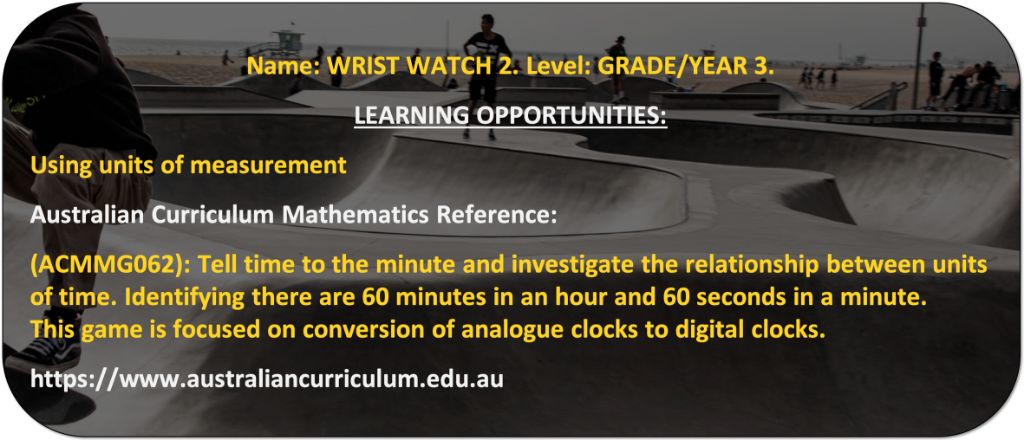
Wrist Watch 2 - Worksheet
WRIST WATCH 3
GAME PLAYS ON: PC & LAPTOP ONLY
Wrist Watch 3 - Game Description
Ages: 8 – 9 years old
Suits: Grade 3 students in Australia, Third Grade students in the U.S.A. & Canada and Year 4 students in England.
This game is focused on digital clocks. Learning to tell time to the minute and how to convert between hours, minutes, and seconds.
This game helps students to investigate and understand the relationship between units of time. Students learn to identify that there are 60 minutes in an hour and 60 seconds in a minute. Set at a skateboard park with lots of fun sound effects it is an engaging way for students to learn time.
The game is also very encouraging as it is filled with positive words building mathematical confidence. It is designed to suit the Mathematics Curriculums of Australia, Canada, England and the U.S.A.
Teacher References:
(ACMMG062): Tell time to the minute and investigate the relationship between units of time. Identifying there are 60 minutes in an hour and 60 seconds in a minute.
This game has time measurements in 5-minute units. For time measurements to the minute, see the game OUTER SPACE.
Ref: Australian Curriculum Mathematics.
How To Play:
You still meet your friends at different times at the skateboard park. Now you have a digital watch and need to know how to read it. Otherwise, you might be late for your friends. Choose one of the times on any watch and click on it. Only 1 of the 4 answers is the correct time. Choose the correct answer and DRAG it to the watch above! Keep doing this until you have done them all. If you get 2 answers wrong in a row, the game will RESTART!
Wrist Watch 3 - Learning Outcomes

Wrist Watch 3 - Worksheet
MUSHROOMS – STANDARD
GAME PLAYS ON: PC & LAPTOP ONLY
Mushrooms - Standard - Game Description
Ages: 8 – 9 years old
Suits: Grade 3 students in Australia, Third Grade students in the U.S.A. & Canada and Year 4 students in England.
Breaking down large numbers to assist addition and multiplication.
This game helps students to understand addition of large numbers. It teaches students how to regroup and rearrange large numbers for easier calculations. It is a good gauge for teachers to judge how well a student grasps addition and multiplication.
Set in the forest with pixies and elf’s, it is a fun and engaging way to learn. The game is full of positive and encouraging words to build mathematical confidence. The game is designed to suit the Mathematics Curriculums of Australia, Canada, England, and the U.S.A.
Teacher References:
(ACMNA055): Recall addition facts and related subtraction facts to develop increasingly efficient mental strategies for computation.
(ACMNA056): Recall multiplication facts of five and ten and related division facts.
(ACMNA053): Apply place value to partition, rearrange and regroup numbers to at least 10 000 to assist calculations and solve problems.
Ref: Australian Curriculum Mathematics.
How To Play:
The village pixie is collecting mushrooms for a feast. Can you help her count them? Click on a set of mushrooms. Add up how many there are in TOTAL. You will be given 4 answer choices, but only 1 is correct. Choose the correct answer. (See the CLUE.) Once you have done all the cards correctly, you will have finished the game and may go to the village feast!
Mushrooms – Standard - Learning Outcomes

Mushrooms – Standard - Worksheet
MUSHROOMS – ADVANCED
GAME PLAYS ON: PC & LAPTOP ONLY
Mushrooms - Advanced - Game Description
Ages: 8 – 9 years old
Suits: Grade 3 students in Australia, Third Grade students in the U.S.A. & Canada and Year 4 students in England.
This is the more challenging game of the mushroom series. Students have more addition and multiplication sums.
This game helps students to understand addition of large numbers. It teaches students how to regroup and rearrange large numbers for easier calculations. It is a good gauge for teachers to judge how well a student grasps addition.
Set in the forest with wizards and pixies, it is a fun and engaging way to learn more challenging multiplication and addition problems. The game is full of positive and encouraging words to build mathematical confidence. The game is designed to suit the Mathematics Curriculums of Australia, Canada, England, and the U.S.A.
Teacher References:
(ACMNA055): Recall addition facts and related subtraction facts to develop increasingly efficient mental strategies for computation.
(ACMNA056): Recall multiplication facts of five and ten and related division facts.
(ACMNA053): Apply place value to partition, rearrange and regroup numbers to at least 10 000 to assist calculations and solve problems.
Ref: Australian Curriculum Mathematics.
How To Play:
This time, a wizard is collecting mushrooms for the village feast. Can you help him count them? Click on a set of mushrooms. Add up how many there are in TOTAL. Choose the correct answer. (See the CLUE.) Once you have done all the cards correctly, you will have finished the game and may go to the village feast!
Mushrooms – Advanced - Learning Outcomes

Mushrooms – Advanced - Worksheet
By the end of Grade 3, students recognise the connection between addition and subtraction and solve problems using efficient strategies for multiplication. They model and represent unit fractions. They represent money values in various ways. They match positions on maps with given information. Students recognise angles in real situations. They interpret and compare data displays. Students count to and from 10 000. They classify numbers as either odd or even. They recall addition and multiplication facts for single-digit numbers. Students correctly count out change from financial transactions. They continue number patterns involving addition and subtraction. Students use units for length, mass and capacity. They tell time to the nearest minute. Students make models of three-dimensional objects. Students conduct chance experiments and list possible outcomes. They conduct simple data investigations for categorical variables.
https://www.australiancurriculum.edu.au

















































